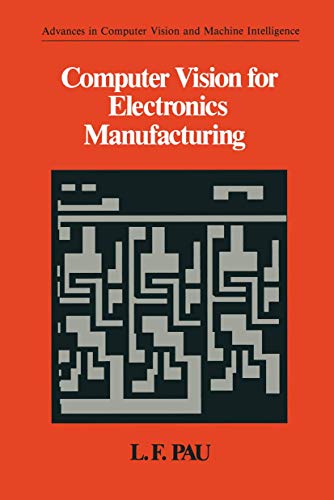Verwandte Artikel zu Computer Vision for Electronics Manufacturing (Advances...
Computer Vision for Electronics Manufacturing (Advances in Computer Vision and Machine Intelligence) - Softcover

Inhaltsangabe
DEFECT PROPORTION OF DETECTION INITIAL RATE DETECTION RATE INSPECTOR 3 COMPLEXITY OF TIMES PAN OF PERFORMING o~ ________________________ o~ ______________________ __ -;. INSPECTION TASK -;. VISUAL INSPECTION Fagure 1. Trends in relations between the complexity of inspection tasks, defect detection rates (absolute and relative), and inspection time. Irrespective of the necessities described above, and with the excep tion of specific generic application systems (e.g., bare-board PCB inspection, wafer inspection, solder joint inspection, linewidth measure ment), vision systems are still not found frequently in today’s electronics factories. Besides cost, some major reasons for this absence are: 1. The detection robustness or accuracy is still insufficient. 2. The total inspection time is often too high, although this can frequently be attributed to mechanical handling or sensing. 3. There are persistent gaps among process engineers, CAD en gineers, manufacturing engineers, test specialists, and computer vision specialists, as problems dominate the day-to-day interac tions and prevent the establishment of trust. 4. Computer vision specialists sometimes still believe that their contributions are universal, so that adaptation to each real problem becomes tedious, or stumbles over the insufficient availabIlity of multidisciplinary expertise. Whether we like it or not, we must still use appropriate sensors, lighting, and combina tions of algorithms for each class of applications; likewise, we cannot design mechanical handling, illumination, and sensing in isolation from each other.
Die Inhaltsangabe kann sich auf eine andere Ausgabe dieses Titels beziehen.
Reseña del editor
DEFECT PROPORTION OF DETECTION INITIAL RATE DETECTION RATE INSPECTOR 3 COMPLEXITY OF TIMES PAN OF PERFORMING o~ ________________________ o~ ______________________ __ -;. INSPECTION TASK -;. VISUAL INSPECTION Fagure 1. Trends in relations between the complexity of inspection tasks, defect detection rates (absolute and relative), and inspection time. Irrespective of the necessities described above, and with the excep tion of specific generic application systems (e.g., bare-board PCB inspection, wafer inspection, solder joint inspection, linewidth measure ment), vision systems are still not found frequently in today's electronics factories. Besides cost, some major reasons for this absence are: 1. The detection robustness or accuracy is still insufficient. 2. The total inspection time is often too high, although this can frequently be attributed to mechanical handling or sensing. 3. There are persistent gaps among process engineers, CAD en gineers, manufacturing engineers, test specialists, and computer vision specialists, as problems dominate the day-to-day interac tions and prevent the establishment of trust. 4. Computer vision specialists sometimes still believe that their contributions are universal, so that adaptation to each real problem becomes tedious, or stumbles over the insufficient availabIlity of multidisciplinary expertise. Whether we like it or not, we must still use appropriate sensors, lighting, and combina tions of algorithms for each class of applications; likewise, we cannot design mechanical handling, illumination, and sensing in isolation from each other.
„Über diesen Titel“ kann sich auf eine andere Ausgabe dieses Titels beziehen.
Neu kaufen
Diesen Artikel anzeigenEUR 13,78 für den Versand von Vereinigtes Königreich nach USA
Versandziele, Kosten & DauerSuchergebnisse für Computer Vision for Electronics Manufacturing (Advances...
Computer Vision for Electronics Manufacturing (Advances in Computer Vision and Machine Intelligence)
Anbieter: Ria Christie Collections, Uxbridge, Vereinigtes Königreich
Zustand: New. In. Artikel-Nr. ria9781461278412_new
Anzahl: Mehr als 20 verfügbar
Computer Vision for Electronics Manufacturing
Anbieter: AHA-BUCH GmbH, Einbeck, Deutschland
Taschenbuch. Zustand: Neu. Druck auf Anfrage Neuware - Printed after ordering - DEFECT PROPORTION OF DETECTION INITIAL RATE DETECTION RATE INSPECTOR 3 COMPLEXITY OF TIMES PAN OF PERFORMING o~ ________________________ o~ ______________________ __ -; INSPECTION TASK -; VISUAL INSPECTION Fagure 1. Trends in relations between the complexity of inspection tasks, defect detection rates (absolute and relative), and inspection time. Irrespective of the necessities described above, and with the excep tion of specific generic application systems (e.g., bare-board PCB inspection, wafer inspection, solder joint inspection, linewidth measure ment), vision systems are still not found frequently in today's electronics factories. Besides cost, some major reasons for this absence are: 1. The detection robustness or accuracy is still insufficient. 2. The total inspection time is often too high, although this can frequently be attributed to mechanical handling or sensing. 3. There are persistent gaps among process engineers, CAD en gineers, manufacturing engineers, test specialists, and computer vision specialists, as problems dominate the day-to-day interac tions and prevent the establishment of trust. 4. Computer vision specialists sometimes still believe that their contributions are universal, so that adaptation to each real problem becomes tedious, or stumbles over the insufficient availabIlity of multidisciplinary expertise. Whether we like it or not, we must still use appropriate sensors, lighting, and combina tions of algorithms for each class of applications; likewise, we cannot design mechanical handling, illumination, and sensing in isolation from each other. Artikel-Nr. 9781461278412
Anzahl: 1 verfügbar

